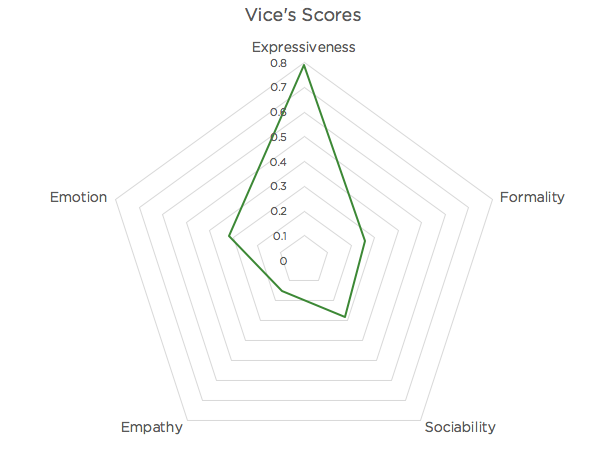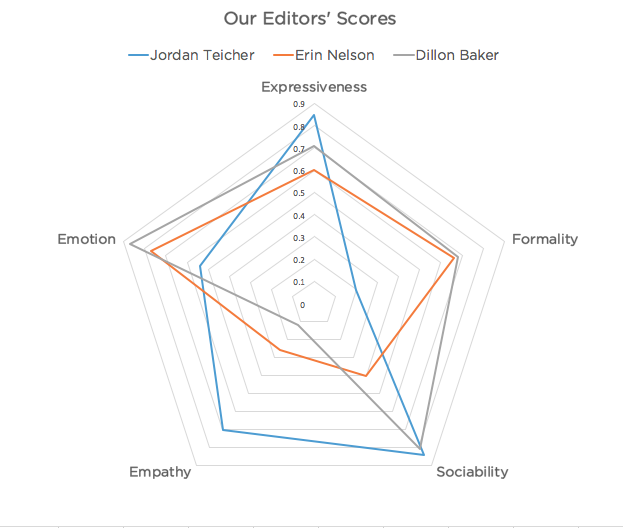B2B Tech
This Tone Analyzer Could Help You Sound Like Your Favorite Publisher
A few days ago, I was on the phone with a marketer from a popular appliance company when I heard this request:
“We want to sound like Vice.”
As a content strategist at Contently, I hear this type of editorial ambition all the time: Brand X wants to be like Vice, Vox, The New York Times. Brands now understand that the voice and tone of their publications will impact audience development. They know that an influx of branded content across the web means their voice and tone are often the most important competitive differentiators.
Yet one of the biggest challenges companies face is deciding what they want to sound like. How do they know if they should model their voice after Vox or The Economist? Are they more research-focused like The New York Times or listicle-based like BuzzFeed? Even if brands decide on a tone, their publications can still struggle to staff the right creative team to bring this decided voice to life.
To address some of these identity issues, we built a tone analyzer at Contently. Here’s how we began.
The tricky business of tone
If you’ve ever been in an argument, you know that tone can determine the meaning of a person’s words and impact your ability to find a resolution. Tone is what we use to interpret if “I’m fine” actually means someone is upset.
In a single piece of writing, tone can be described as the writer’s attitude or approach to the subject matter. It can express a particular mood, feeling, or character. For an entire publication, tone establishes the ethos of a company and the values of its authors.
Sometimes, it’s easiest to recognize characteristics of tone and style when they’re not quite right. Many brands come to Contently because their previous efforts to sound authoritative and professional come off as condescending or detached. Others want to develop a more approachable personality if they have a reputation for being unrelatable.
When deciding how to move forward with tone, our clients often reference a blue-chip publication they want to emulate, but whose editorial focus has little or nothing to do with what they offer. For instance, a company that sells insurance may want to sound like a notoriously colloquial political mag.
When that dissonance shows up, brand marketers need to be able to give guidance to their creative teams. Especially when working with freelancers who write for a variety of publications, it is crucial to prep creatives on the right tone for their audience. Articulating that they want to be more Vox, less Wall Street Journal is an important distinction—and one that writers will understand.
But the result of these high-level instructions too often leads to a road of strategic dead-ends. Lofty comparisons are full of paradoxical concepts that make it hard to publish. When a consumer packaged goods brand wants to sound like an episode of Last Week Tonight With John Oliver in its video product launch, or an insurance company wishes to capture the je ne sais quoi of Real Simple, what does this mean for the people creating and measuring the impact of this content?
Time and again, there is a disconnect between creatives who have the right tone but the wrong expertise. (John is a former Vox writer, but he knows nothing about the complexities of insurance.) The reverse can also be the case. (Joanna is an insurance expert, but she writes like a dry academic.)
Our goal on the strategy team is to marry tone and expertise so an insurance company, for example, doesn’t have to choose between risk assessment knowledge and punchy prose.
Enter the tone analyzer.
The tone analyzer test
The Five Factor Model, or the “Big Five,” is a personality classification system that bases its framework on major traits: openness, conscientiousness, extraversion, agreeableness, and emotional range (sometimes called “neuroticism”). The model emerged in 1961 and came from psychologists Ernest Tupes and Raymond Christal at the Air Force’s Research Division.

Building on the work of earlier psychologists who extracted nearly 18,000 words from the dictionary that related to human personality traits, Tupes and Christal reduced this list and lumped the remaining terms into five key groups based on recurring factors. Today, the Big Five remains a useful set of building blocks in understanding not only who we are but also how we communicate.
At Contently, we’ve taken the principles of the Five Factor Model to construct our own tone analyzer that will make pairing writers and brands more data driven. Because we’re analyzing content, rather than actual people, we’ve given each traditional trait a new, more editorially friendly name.
How does it work? The analyzer scrapes a website for as much text as possible, then assigns this aggregated content with a numeric “score” for each of the Big Five personality traits. The process is the same for analyzing a writer’s body of work. Scores range from zero to one.
By assessing the trait scores, we can detect the character of the publication or writer, and match the two accordingly.
The publication score
As a test, I ran Vice’s three most-shared pieces over the past year (this, this, and this, if you’re curious) to get a sense of the publication’s tone. Based on these articles, Vice scores 0.79 for expressiveness, 0.26 for formality, 0.28 for sociability, 0.15 for empathy, and 0.32 for emotion.

Using the Big Five personality key, here’s what we can deduce from these scores:
- Expressiveness 0.79: A high score for expressiveness suggests Vice’s writing is imaginative and that writers are willing—and allowed—to take risks.
- Formality 0.26: The low formality score lets us know the tone lacks authority. It is extremely laid-back and casual.
- Sociability 0.28: A lower score for sociability reveals Vice is restrained and confident in its approach, as opposed to being highly empathetic or open to new ideas.
- Empathy 0.15: Low empathy signals a significant amount of skepticism and comfort in embracing confrontation.
- Emotion 0.32: The low-to-middle emotion score points to a somewhat relaxed attitude. The site doesn’t rely too much on data.
The writer score
Once we go through this same process for creatives, we can pair writers to a brand publication based on that company’s desired tone. It’s worth noting that the point of the tone analyzer isn’t to just find writers with the same voice. If a brand wants to be more emotional, it might target authors with a higher emotional score than its own.
For the second part of the experiment, we scraped the portfolios of three of our TCS editors to find out who would be the best fit for Vice Magazine—or a brand that wants to mimic its tone.

Senior editor Jordan Teicher and associate editor Dillon Baker both ranked high in expressiveness, meaning, like Vice, their writing is imaginative, capable of explaining abstract concepts, and uses anecdotes to strengthen the narratives. But Jordan’s sociability and empathy marks were too high for Vice. [note]Fun fact: He’s written three stories for Vice[/note] Dillon’s formality, sociability, and emotion scores were significantly different from Vice’s as well.
Meanwhile, marketing editor Erin Nelson ranked low for empathy, meaning she is comfortable writing punchy prose that gets the audience to question the status quo, which lines up well with Vice’s approach. Her expressiveness and sociability splits were also close.

When we look at the differences, we see Erin most closely resembles the Vice voice across the five factors. (The closer to zero, the better the score.) If this were a real Contently staffing situation, and Erin had the most relevant industry experience for the brand, the tonal analyzer would suggest she’s the best person for the job.
Toning up
Ultimately, many factors play into the “talent matching” process at Contently. Finding the perfect team of writers for your content operation depends on the depth and relevance of their experience, location, availability, and more. But when a brand considers how it wants to sound, the tone analyzer can help quantify abstract goals and get team leaders to think about the type of writers who can create content that fulfills those goals.
So if an appliance company wants to sound as relatable as Vice Magazine, it’s our job to make sure the content creators can bring the right edge, even if they’re talking about blenders and washing machines.
Get better at your job right now.
Read our monthly newsletter to master content marketing. It’s made for marketers, creators, and everyone in between.




